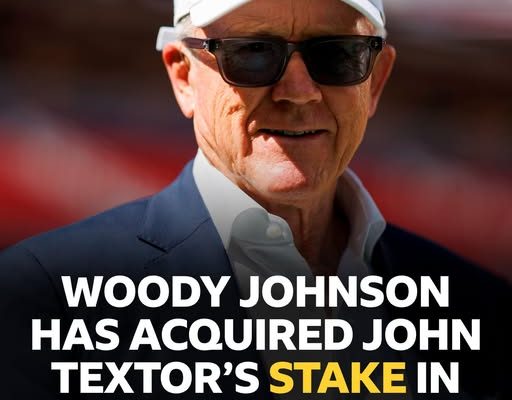New York Jets owner Woody Johnson has officially completed his purchase of John Textor’s 43% stake in Crystal Palace Football Club, marking a significant shift in the ownership landscape of one of the English Premier League’s most storied teams. This bold acquisition by Johnson signals not just a deepening interest in global sports ownership among American billionaires, but also a potentially transformative moment for the South London-based club. While Crystal Palace has long stood as a respected mid-table Premier League team with a loyal fanbase and deep community roots, the injection of new ownership—particularly with the financial backing and sports-business savvy of someone like Johnson—brings with it the promise of modernization, expansion, and possibly loftier ambitions both on and off the pitch.
Johnson, who has owned the New York Jets since 2000, is no stranger to the complexities of high-level sports ownership. His two-decade tenure with the NFL franchise has been marked by a blend of passion, strategic investments, and occasional controversy, all of which have made him a prominent figure in American sports circles. His pivot to international soccer, however, underscores a growing trend among NFL owners and U.S. billionaires seeking opportunities to invest in European football, where the market potential continues to grow exponentially. With global TV rights, branding opportunities, and a youth-oriented fan base ripe for digital monetization, the Premier League presents a compelling case for expansion-minded owners.
The sale of John Textor’s 43% stake was, in itself, a significant development in the recent history of Crystal Palace. Textor, who initially invested in Palace in 2021, had hoped to spearhead a multi-club model similar to the approaches taken by Red Bull and City Football Group. Through his company Eagle Football Holdings, he also acquired stakes in Lyon, Botafogo, and RWD Molenbeek. Yet his vision for integrated player development, shared resources, and centralized talent scouting clashed with existing ownership structures and regulatory hurdles, leading to strategic disagreements and a complex operational environment. By divesting his Palace stake, Textor now seems poised to focus more acutely on his other ventures—most notably Olympique Lyonnais—leaving the London club in need of a new strategic direction.
Woody Johnson’s entrance into the picture could not be more timely. Crystal Palace, having spent over a decade in the top flight since their promotion in 2013, have stabilized as a competitive Premier League side, but often find themselves hovering in the mid-to-lower table zone. The club has consistently survived relegation threats, boasted breakout stars like Wilfried Zaha and Eberechi Eze, and developed a strong academy system. Yet, without substantial investment, particularly in facilities, scouting infrastructure, and marquee transfers, Palace has lacked the punch to break into the upper echelon of the league. Johnson’s acquisition may serve as the catalyst for a more ambitious chapter in the club’s history.
Sources close to the deal say Johnson has no immediate intention of overhauling the current leadership team, with chairman Steve Parish expected to remain involved in club operations. This signals a desire for continuity, rather than abrupt transformation. However, Johnson is reportedly interested in expanding the club’s commercial footprint, improving Selhurst Park’s infrastructure, and increasing the investment in youth development. Palace’s academy, which has already produced a number of Premier League-caliber talents, could be the nucleus of a longer-term strategy focused on both domestic success and lucrative player sales.
What distinguishes this deal from other recent American forays into English football is Johnson’s singular focus on Crystal Palace as a standalone project, rather than part of a multi-club portfolio. While fellow American investors have diversified into numerous clubs to spread risk and share resources, Johnson appears committed to establishing Palace as a flagship brand. His experience in managing the financial operations of a major NFL franchise may come in handy as he seeks to replicate elements of that commercial success within the Premier League framework. From ticketing models and digital fan engagement to sponsorships and merchandising, Johnson brings a wealth of knowledge from the U.S. sports business world—an industry where maximizing revenue per fan is treated like an art form.
The timing of this transaction is also worth noting. The Premier League is currently undergoing a critical self-reflection phase regarding financial sustainability, club governance, and regulatory oversight. With the looming implementation of stricter Financial Fair Play regulations and pressure on owners to act responsibly, Johnson’s reputation as a conservative yet effective financial manager might position Palace well to navigate these turbulent waters. His background as a former U.S. ambassador to the United Kingdom under the Trump administration could also serve as a unique diplomatic advantage, facilitating smoother communication between the club, the Premier League, and potential European partners.
Crystal Palace’s fanbase has understandably met the announcement with a mixture of hope and skepticism. Many long-time supporters recall earlier ownership shake-ups that did little to fundamentally change the club’s trajectory. Some fear that foreign investment might dilute the club’s identity or prioritize commercial gain over community involvement. Others, however, view Johnson’s entry as a long-awaited opportunity to finally bridge the gap between survival and genuine competitiveness. The idea of competing for European qualification spots or investing in globally recognized talent no longer seems like a far-off dream.
In Johnson’s brief public remarks following the deal’s confirmation, he emphasized a commitment to respecting the club’s traditions while seeking “sustainable growth and long-term success.” This measured language stands in contrast to some of the more bombastic rhetoric seen from other American owners upon entering European football, and may reflect lessons learned from his NFL experience. The New York Jets have not always been the most successful team on the field during his ownership, but Johnson has overseen major upgrades to the team’s training facilities, branding initiatives, and global outreach. He appears to be taking a similar approach with Crystal Palace—slow, deliberate, and rooted in infrastructural development.
For now, the football world will watch closely as this new era begins at Selhurst Park. The upcoming transfer windows will be a litmus test of Johnson’s ambition and financial commitment. While fans may not expect immediate blockbuster signings, there is already growing chatter about increasing Palace’s scouting reach in South America and West Africa—regions historically underutilized by the club. There are also rumors of possible partnerships with U.S.-based sports marketing firms and tech startups specializing in athlete performance analytics, suggesting that innovation may become a hallmark of the Johnson era.
Of course, any shift in ownership also brings geopolitical narratives into the mix. Johnson’s high-profile ties to American politics have already raised eyebrows in some circles, particularly given the Premier League’s recent push for more transparent and ethically sound ownership. Critics have pointed out that Johnson’s appointment as U.S. ambassador was mired in political controversy, and some worry that his leadership style might clash with the inclusive and community-driven ethos of English football. Still, there’s little doubt that he passes the Premier League’s Owners’ and Directors’ Test, and with his acquisition now finalized, his actions will speak louder than past affiliations.
There’s also the question of synergy between Johnson’s dual sports investments. Could there be crossover opportunities between the New York Jets and Crystal Palace? While the sports themselves are vastly different, there are overlapping areas in training science, injury prevention, and marketing. Johnson may look to create a bi-continental brand that leverages the popularity of football on both sides of the Atlantic, possibly even exploring joint promotional campaigns or merchandise collaborations. It’s not hard to imagine a future where Palace jerseys are marketed to NFL audiences or Jets gear becomes a familiar sight at Selhurst Park.
In the short term, Johnson will need to win over players, staff, and fans alike. This includes making clear commitments to the team’s competitive ambitions, community programs, and heritage preservation. While ownership changes can often create uncertainty within the dressing room, early reports suggest that Palace players have been briefed and are cautiously optimistic about what this new chapter might bring. The club’s current manager is also expected to receive increased backing in the upcoming season, with at least two to three strategic signings potentially on the horizon.
Ultimately, Woody Johnson’s purchase of John Textor’s 43% stake in Crystal Palace represents more than just a financial transaction. It’s a statement of intent, a realignment of priorities, and a vision for growth that could lift a traditionally mid-tier Premier League club into a more ambitious future. Whether that future leads to top-six finishes, European nights, or simply a more stable and modern club culture, one thing is clear: the winds of change are blowing through South London, and Woody Johnson is now at the helm.



